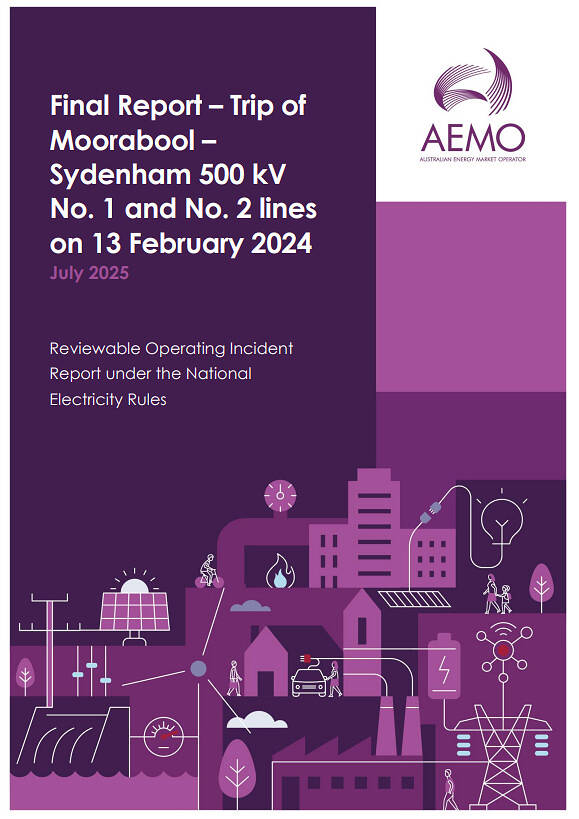As of July 2025, the final report reviewing the power system incident on the 13th of February 2024 is released.
This report follows the early preliminary report released soon after the event in 2024.
The final report covers the event, pre, during and post in detail.
We don’t aim to summarise everything in the report in this article. The report is comprehensive. Here we limit ourselves in highlight some aspects out of the many that may interest you to read the report in full.
Destructive winds
The summary of conclusions addresses the extreme nature of the weather on the day, including:
“Independent meteorological expert analysis commissioned by AusNet following the event concluded that there were likely wind gusts in the range of 150-170 kilometres per hour (km/h) at a height of 10 metres and up to 191-216 km/h at an altitude of 50 metres.”
Power system faults on the 500kV network
Both (there are two) 500kV lines between Moorabool and Sydenham terminal stations tried to reclose but couldn’t – the transmission towers had collapsed under the extreme winds –
“As the towers had collapsed, each of these reclosures resulted in a non-credible 3-phase fault on the power system.”
“This resulted in significant impacts to generation and demand in Victoria.”
Coal conveyor systems and fault ride-through
The report spends a good portion reviewing what happened at Loy Yang A.
88% of the 2,507 MW of generation lost in Victoria (2,210 MW in aggregate from 4 steam turbine generating units) was from Loy Yang A.
The network experienced voltage disturbances when the 3-phase faults occurred as auto-reclosure of the lines was attempted (at Sydenham). These voltage disturbances made their way across the network to Loy Yang A.
The report, referencing AGL’s post-event investigation, finds that the voltage dips actually caused the coal feeder conveyor systems to restart. This effectively slowed the supply of fuel to the boiler which resulted in a loss of furnace pressure which triggered a “master fuel trip” (MFT). The MFT happened about 20 seconds after the last voltage dip. This MFT triggered a runback sequence on all four units reducing their generation to zero over 45 seconds. The units then tripped shortly afterwards on reverse power flows once the runback had completed.
Although this response was not desirable, AEMO concluded the response was compliant with the station’s generator performance standards
The report makes many recommendations. The two that relate to events at Loy Yang A might be of interest to readers:
- AEMO recommends that registered participants for all coal fired power stations in the National Electricity Market (NEM) review their coal conveyor systems’ settings to identify any similar risks to multiple fault ride through and advise AEMO of any risks.
- AEMO recommends that registered participants for all synchronous generators in the NEM consider whether any other auxiliary plant settings are in place that could result in the plant failing to ride through multiple faults and advise AEMO of any
risks.
A third recommendation, on the loss of generation in general, is also given:
- AEMO plans to consider the risks highlighted by the significant loss of generation in this event in the 2026 General Power System Risk Review (GPSRR).
Generation from distributed PV was shaken off
“Approximately 1,294 MW underlying load and 424 MW of distributed PV was shaken off during the event, leading to 870 MW net drop in operational demand”
This aspect also is earmarked for the 2026 GPSRR.
Better estimates of distributed PV are needed
A significant portion of the underlying load that was shaken off was being met supplied by distributed PV. The report noted that the present 30-minute granularity and time lag meant that large differences from 5-minute estimates occurred as conditions changed rapidly.
“AEMO is developing a new 5-minute distributed PV generation estimate value (ASEFS3), which aims to increase granularity of the distributed PV generation estimated actuals and forecasts and reduce delays in accounting for changing grid and weather conditions. This is expected to be implemented by the end of 2025.”
All that, and more
The report includes review of how the power system was operated in the hours after the lines tripped.
The report also includes wholesale market analysis (including bids). It reviews impacts on the gas market.
It explains the conditions that led to erroneous interconnector limits for some intervals.
The report acknowledges the 33 Participants who supported the review by providing data.



The question now is: how many 100s of kms of transmission lines do we have which will not survive wind speeds under global warming conditions?